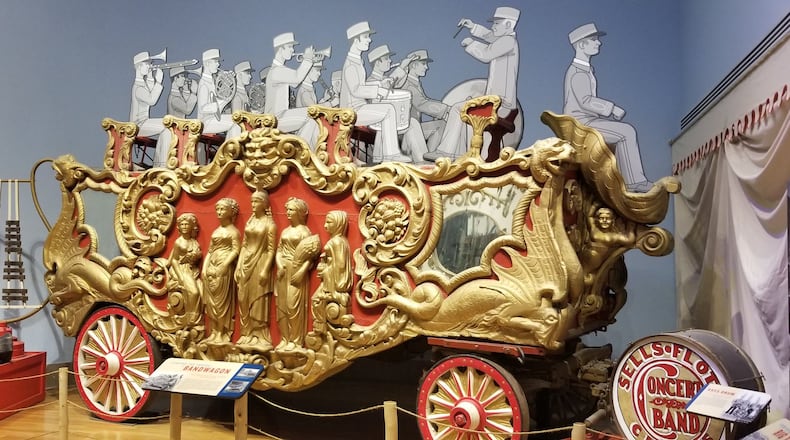“Ladies and gentlemen, boys and girls, children of all ages, get ready for the Greatest Show on Earth!”
That's how ringmaster Harold Ronk opened the Ringling Bros. and Barnum & Bailey Circus for 30 years, starting in 1951, setting the mood for the breathtaking extravaganza that was to come. Then he would belt out "Welcome to the Circus," his classically trained baritone reverberating around the arena.
Ringling Bros. ended its 146-year run in 2017, but the show lives on, along with Ronk’s red-sequined and gold-trimmed tailcoat, at Ringling Bros. Circus Museum, part of the sprawling Ringling Estate in Sarasota, Fla., that was the winter home of circus impresario John Ringling and his wife Mable during the 1920s.
There was a time when the arrival of the circus was like Christmas, especially for kids, and schools and businesses in many communities closed so everyone could enjoy the rare diversion.
To understand the magic of the circus in its early 20th century heyday, you have to imagine a time before Americans were inundated with entertainment options. Today, Netflix and Amazon are just a click away, but long before every household had a TV and internet access, exotic animals and daring circus performers from foreign lands were truly a marvel.
“The cool thing about the circus is that it brought the world to the local community,” said Executive Director Steven High. “The performers may have been presented in stereotypical costumes, but the circus brought people of all different cultures to monocultural communities. And the animals came from all over the world. At that time, there weren’t that many zoos, especially in rural areas, so to have this menagerie of animals was quite an attraction.”
Shows with dancing elephants, magnificent lions and pouncing tigers with fang-like canine teeth thrilled audiences.
In later years, animal rights groups criticized the use of performing animals, and in 2016, Ringling retired its famous elephants to a Florida conservation farm.
A noteworthy artifact on display is an elaborate 19th century bandwagon adorned with five carved female figures dubbed “The Five Graces.” Loaded with musicians playing spirited tunes, the bandwagon led the street parades on Barnum & Bailey European tours. It was an effective way of announcing the circus was in town before the advent of modern advertising methods, such as radio and TV.
A museum highlight is the Ringlings’ private rail car, the Wisconsin, that allowed the wealthy owners to travel the country in style. Built in 1896 and outfitted with plush furnishings, it served as a mobile apartment and office.
Ringling was a savvy businessman. The circus is his legacy, but he also invested in real estate and played a major role in developing Sarasota County.
To gain more insight into Ringling’s life, watch the PBS-produced film screened regularly in the museum.
In addition to the museum, there are other attractions on the estate that visitors will want to explore.
Howard Tibbals Learning Center
You could say Howard Tibbals ran away with the circus. Not literally, but he was so intrigued by everything associated with the big top, his imagination ran away with him.
The 83-year-old Tennessee native spent 50 years creating the world’s largest miniature circus.
Started in 1956 and presented to the Ringling Estate in 2006, the Howard Bros. Circus is a 3,800-square-foot scale model of the Ringling Bros. and Barnum & Bailey traveling big top shows of the 1920s and ‘30s. It is exhibited at the Howard Tibbals Learning Center, a facility Tibbals helped fund to give his beloved circus a permanent home and to provide a place for scholarly research centered on circus history.
Thousands of hand-carved and painted figures comprise an illuminated diorama depicting the tented, ephemeral city that had to be uprooted and moved every day. Tibbals even referenced vintage posters and historical photographs to accurately portray circus life in painstaking detail.
“Kids are fascinated by it,” said High. “They get this experience of seeing a magical world that doesn’t exist anymore. There are so many stories going on in that model, and they can even come up with their own stories. The sheer scale is impressive, no matter how old you are.”
The first model Tibbals made as a teenager was a rail car. Six decades later, the train has 59 railcars. The model also depicts elephants and other animals being unloaded as curious townspeople observe the scene from the tracks.
Visitors are forever pressing their faces to the glass for a closer look at the detailed minutia of the performers’ costumes, eye-catching posters advertising the lady sword swallower and the world’s tallest man, even the food on plates in the canteen.
A tour of Ca’d’Zan, John and Mable Ringling’s 56-room residence, takes visitors back to the Roaring ‘20s, a time of unabashed ostentatiousness and glamour. By the time the Ringlings made Sarasota the winter quarters for the circus in 1927, construction of their mansion on Sarasota Bay had been completed and filled with art and antiques from decades of travel.
Designed by Dwight James Baum, the 36,000-square-foot Venetian palazzo is awash in gorgeous architectural details, both inside and out. At lavish parties, guests whirled around the vast ballroom, but they would have missed the room’s most interesting feature unless they looked up. The ceiling mural, “Dances of Nations,” showcases 22 vignettes of dancing couples from around the world.
The Ringlings dined beneath a silver chandelier on a table laid with Tiffany flatware embellished with an intricate Persian pattern, reportedly the most expensive and elaborate motif the company ever produced.
The home’s crowning glory is the 82-foot-tall Belvedere Tower, modeled after the Seville Cathedral bell tower in Spain. A glorious view of the sky and sea is framed through Gothic arches.
Cavernous as it is, Ca’d’Zan couldn’t contain the Ringlings’ vast collection of Baroque paintings and other artworks. To ensure that their treasures were accessible to future generations, the philanthropic couple founded the John and Mable Ringling Art Museum in 1927 as their legacy to the people of Florida. Today, the 21-gallery facility is the state art museum.
Masterpieces by Rembrandt, Gainsborough and other luminaries are displayed in a pink, Mediterranean-style palazzo that surrounds a graceful, sculpture-filled courtyard.
The most celebrated work is Reubens’ “Triumph of the Eucharist,” five massive canvases commissioned by Spanish Infanta Isabella Clara Eugenia in the 17th century to glorify Catholicism. Originally, there may have been as many as 20.
The Ringling Estate provides more than just a stroll through the remnants of a bygone era of American entertainment. It also offers a glimpse of the man behind it all. Ringling’s shows made people laugh, but he was dead serious when it came to his dual passions of art and business.
IF YOU GO
Ringling Estate. "Knights," an exhibit of Medieval armor and weaponry, is on view through April 21. $25-$5, children 5 and younger free. Includes admission to the Circus Museum and Museum of Art. Tours of Ca'd'Zan, $40-$10. 10 a.m.-5 p.m. daily except Thursday when it closes at 8 p.m. 5401 Bay Shore Road, Sarasota, Fla., 941-359-5700, www.ringling.org.
About the Author
Keep Reading
The Latest
Featured





